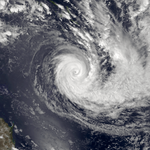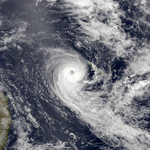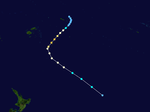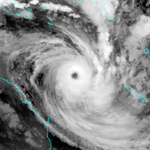1981–82 South Pacific cyclone season
| 1981–82 South Pacific cyclone season | |
|---|---|

Season summary map
|
|
| Seasonal boundaries | |
| First system formed | December 18, 1981 |
| Last system dissipated | May 18, 1982 |
| Strongest storm | |
| Name | Gyan |
| • Maximum winds | 185 km/h (115 mph) (10-minute sustained) |
| • Lowest pressure | 925 hPa (mbar) |
| Seasonal statistics | |
| Total depressions | 6 |
| Tropical cyclones | 6 |
| Severe tropical cyclones | 5 |
| Total fatalities | Unknown |
| Total damage | Unknown |
| Related articles | |
| Category 4 severe tropical cyclone (Australian scale) | |
| Category 3 tropical cyclone (SSHWS) | |
| Duration | December 18 – December 29 |
|---|---|
| Peak intensity | 185 km/h (115 mph) (10-min) 925 hPa (mbar) |
| Category 3 severe tropical cyclone (Australian scale) | |
| Category 1 tropical cyclone (SSHWS) | |
| Duration | January 24 – February 1 |
|---|---|
| Peak intensity | 130 km/h (80 mph) (10-min) 965 hPa (mbar) |
| Category 3 severe tropical cyclone (Australian scale) | |
| Category 3 tropical cyclone (SSHWS) | |
| Duration | February 1 – February 7 |
|---|---|
| Peak intensity | 130 km/h (80 mph) (10-min) 953 hPa (mbar) |
| Category 4 severe tropical cyclone (Australian scale) | |
| Category 3 tropical cyclone (SSHWS) | |
| Duration | February 27 – March 5 |
|---|---|
| Peak intensity | 175 km/h (110 mph) (10-min) 930 hPa (mbar) |
| Category 4 severe tropical cyclone (Australian scale) | |
| Category 2 tropical cyclone (SSHWS) | |
| Duration | April 5 – April 9 |
|---|---|
| Peak intensity | 175 km/h (110 mph) (10-min) 945 hPa (mbar) |
| Category 1 tropical cyclone (Australian scale) | |
| Tropical storm (SSHWS) | |
| Duration | May 13 – May 18 |
|---|---|
| Peak intensity | 75 km/h (45 mph) (10-min) 990 hPa (mbar) |
The 1981–82 South Pacific cyclone season was a near normal South Pacific tropical cyclone season, with 6 tropical cyclones occurring within the South Pacific Ocean basin between 160°E and 120°W during the season. After the season ended, the names Gyan and Isaac were removed and retired from the lists of names, after they caused significant impacts to South Pacific island nations.
During the season, tropical cyclones were monitored by the Tropical Cyclone Warning Centers in Nadi, Fiji, Brisbane, Australia and Wellington, New Zealand. During the season TCWC Nadi issued warnings and assigned names to any tropical cyclones that developed between the Equator and 25°S while TCWC Wellington issued warnings for any that were located to the south of 25°S. The United States Armed Forces through the Joint Typhoon Warning Center (JTWC) and Naval Pacific Meteorology and Oceanography Center (NPMOC), also monitored the basin and issued unofficial warnings for American interests. TCWC Nadi, Brisbane and Wellington measured sustained windspeeds over a 10-minute which are compared to the modern day Australian tropical cyclone intensity scale. The JTWC and the NPMOC measured sustained windspeeds over a 1-minute period which are compared to the Saffir-Simpson Hurricane Scale (SSHS).
Severe Tropical Cyclone Gyan existed from December 18 to December 29.
...
Wikipedia












